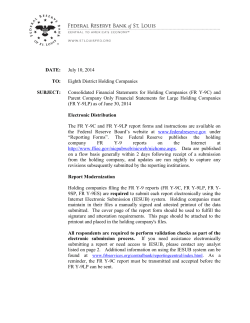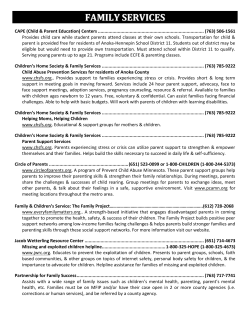
What to Expect When Your Employee is Expecting: A Primer on Pregnancy
The Employers’ Association Newsletter | April 2012 What’s Inside? EA Staff and Board Members 2 Social Media Who Owns Your Company’s Tweeps? 4 What to Expect When Your Employee is Expecting: A Primer on Pregnancy Discrimination Law Discrimination based on pregnancy is prohibited by both Health and Wellness Easy Tips to Help Dodge Diabetes 5 Workers’ Compensation Workers’ Compensation: MCOs and TPAs 7 Sickness Germy Surfaces 7 Hotline Hits 8 EA Partners What Smart Employers Should Know About Generic Drugs 9 Patient Protection and Affordable Care Act Final Rule on Contraceptives Under PPACA 12 federal and state laws. Depending on the size of your company, various laws may apply. Employers of 4 or more employees must comply with Ohio’s antidiscrimination laws. Employers of 15 or more employees are also subject to Title VII of the federal Civil Rights Act as well as the Pregnancy Discrimination Act. Essentially, these laws require that pregnant employees be treated the same as non-pregnant employees with respect to all company benefits, policies and procedures, including those involving leaves of absence. Employers with less than 50 employees are not subject to the federal Family and Medical Leave Act, which provides for unpaid leave after the birth or adoption of a child. Many small companies are surprised to learn, however, that Ohio law requires employers to provide eligible employees with a “reasonable” maternity leave. (Pregnancy Primer continued on page 3) 1787 Indian Wood Circle, Suite A Maumee, OH 43537 | 419-893-3000 April 2012 Page 01 President Print Media EA Health Plus Jack Hollister President; ext. 204 jhollister@employersassociation.com Sarah Beddoes Print Media/Seminar Training Assistant; ext. 207 sbeddoes@employersassociation.com Jennifer Kiernan EA Health Plus Manager; ext. 212 jkiernan@employersassociation.com HR Research Cheryl Riggs HR Member Services Manager; ext. 202 criggs@employersassociation.com CJ Gordon HR Research / Wellness Assistant; ext. 210 cgordon@employersassociation.com Seminar Training Member Services Barb Rains Member Service Coordinator; ext. 205 brains@employersassociation.com Eliana Klein Membership Development Coordinator; ext. 209 eklein@employersassociation.com Terry Vernier Project Manager; ext. 213 tvernier@employersassociation.com Karen Wagenknecht Administrative Assistant; ext. 200 karenw@employersassociation.com Judi Roe HR Research / Training Assistant; ext. 203 jroe@employersassociation.com Accounting Kayla Jaimez Wellness Champion; ext. 211 kjaimez@employersassociation.com Cory Panning Wellness Assistant; ext. 214 cpanning@employersassociation.com On-Site Training and Consulting Dave Tippett, PHR Director, On-site Training and Consulting; ext. 206 dtippett@employersassociation.com Vicki Bender Accountant; ext. 201 vbender@employersassociation.com Board of Directors Chairperson Thomas Kolena, CPA/ABV, CPA/CFF – 2013 Managing Partner / Mira + Kolena, Ltd. Michael Bieringer – 2014 Senior Director, HR / Amcor Rigid Plastics NA Sheri Caldwell – 2014 Client Manager / Medical Mutual of Ohio Duane Carey – 2014 V.P. of Sales & Marketing / Impact Products LLC Frank Day – 2013 V.P. Employee Services / Wood County Hospital Assn Robert F. Deardurff - 2012 President / Phoenix Technologies Stephen (Steve) M. DeDonato – 2013 Director, Compensation & Benefits / The Andersons, Inc. Adele M. Jasion – 2014 Partner / Gilmore, Jasion & Mahler Malcolm C. Richards – 2012 CEO/President / Supplemental Staffing Jeff Schulte – 2013 VP of Human Resources / Lutheran Homes Society Joyce Slusher – 2013 Director, Information Technology / Libbey Inc. Karen Ward - 2012 Human Resource Manager / AAA Northwest Ohio Linnie B. Willis – 2014 Executive Director / Lucas Metropolitan Housing Authority Cheryl Wolff – 2012 Attorney / Spengler Nathanson P.L.L. Jennifer Wuertz — 2012 Human Resources Business Leader / SSOE, Inc. Sarah Zibbel— 2014 Director, Corporate Human Resources / Owens-Illinois 1787 Indian Wood Circle, Suite A Maumee, OH 43537 | 419-893-3000 April 2012 Page 02 Discrimination (Pregnancy Primer continued from page 1) In McFee v. Nursing Care Management of America, Inc., the Ohio Supreme Court recently held that employers can require pregnant employees to meet length-of-service requirements in leave policies. The Court made clear, however, that if an employer provides leave benefits and the pregnant employee meets the eligibility requirements, the benefits must be extended for pregnancy and maternity leave. In the same opinion, the Court also endorsed the Ohio Civil Rights Commission’s “reasonable” maternity leave requirement, which provides that “when a woman qualifies for leave, the leave provided for childbearing must be reasonable.” What is a “reasonable” maternity leave? Although neither the statute nor the regulations define a “reasonable” leave, the Ohio Civil Rights Commission considers up to twelve weeks of maternity leave to be reasonable - six weeks for a normal delivery and perhaps an additional six weeks if there are complications with the pregnancy or delivery. If such complications are claimed, the employer may require that the employee provide documentation from her physician to substantiate the need for an additional period of leave. Employers should also be aware that under both the FMLA and Ohio law, employers must promptly reinstate employees at the conclusion of maternity leave. Companies that successfully navigate the maternity leave and reinstatement requirements can inadvertently engage in pregnancy discrimination in other ways. The following Do’s and Don’ts may help to keep your company out of trouble: • • • • • • Don’t retaliate against a newly hired employee who announces a pre-existing pregnancy. Applicants are not required to reveal pregnancies during the application and selection process. Don’t refuse to hire or promote a pregnant employee based on assumptions that she will require time off or may elect not to return to work after maternity leave. Don’t make assumptions regarding a pregnant employee’s ability to perform her job while pregnant. Unless and until the employee requests an accommodation or the employer receives work restrictions from the employee’s doctor, the employer should not unilaterally limit duties due to safety, convenience or other concerns that only arose because of the pregnancy. (Remember, however, that pregnant employees are not immune to counseling or discipline for poor performance.) Don’t reassign or reallocate a pregnant employee’s duties based on the prejudices or concerns of coworkers, clients, or customers. The fact that the discriminatory opinions of others precipitated a change does not insulate the employer from liability. Do ensure that no additional, increased or larger health insurance deductible is imposed upon pregnant employees. Employers must also provide the same level of health benefits for spouses of male employees as they do for spouses of female employees. Do ensure that employees with pregnancy related disabilities are treated the same as other temporarily disabled employees for accrual and crediting of seniority, vacation, pay increases and temporary disability benefits. Finally, “Do” seek legal advice before making employment decisions impacting pregnant employees. A prior review of options, strategies and potential liability is advisable and may save your company the time, money and aggravation associated with defending against a discrimination claim. (Carrie L. Sponseller and Colleen L. Dietrich; Eastman & Smith Ltd.; 3/12) 1787 Indian Wood Circle, Suite A Maumee, OH 43537 | 419-893-3000 April 2012 Page 03
© Copyright 2025





















